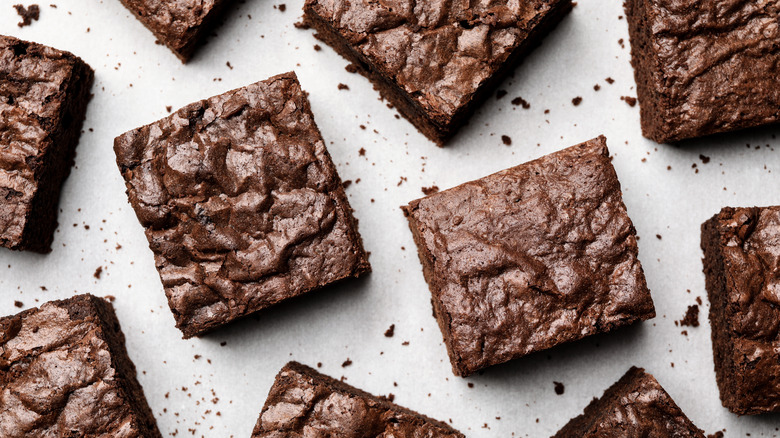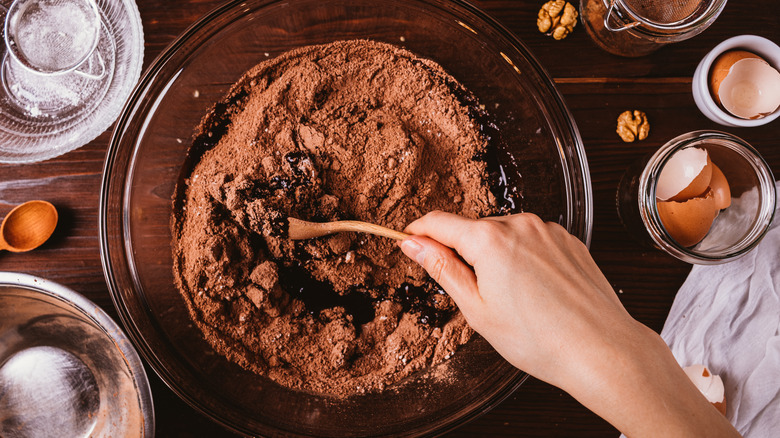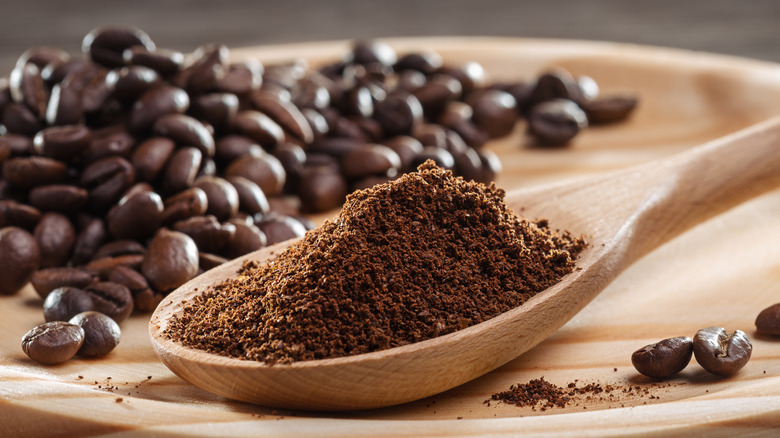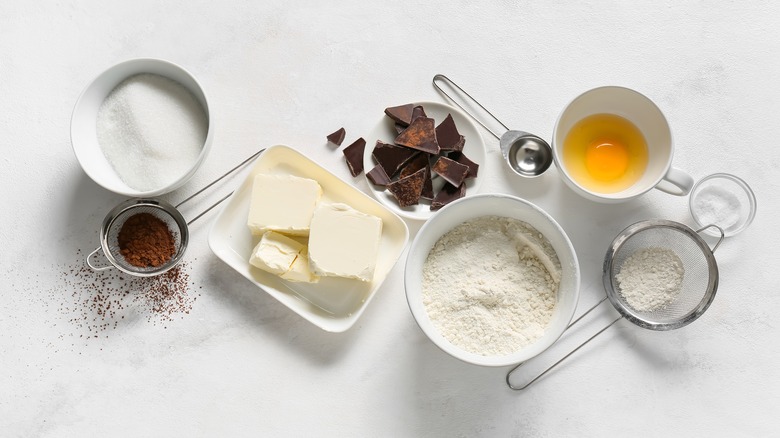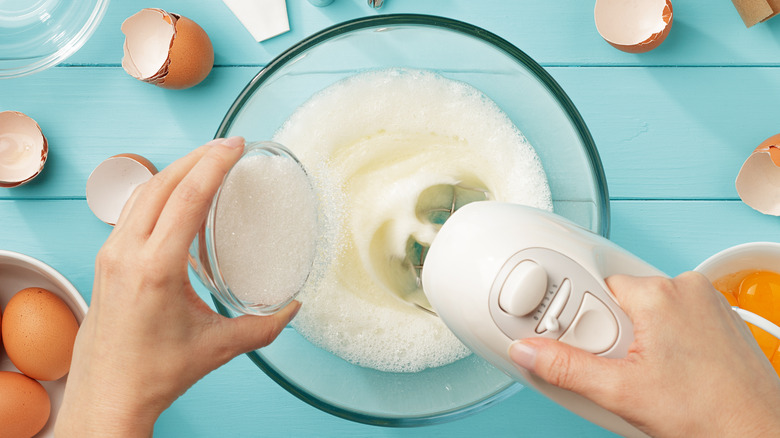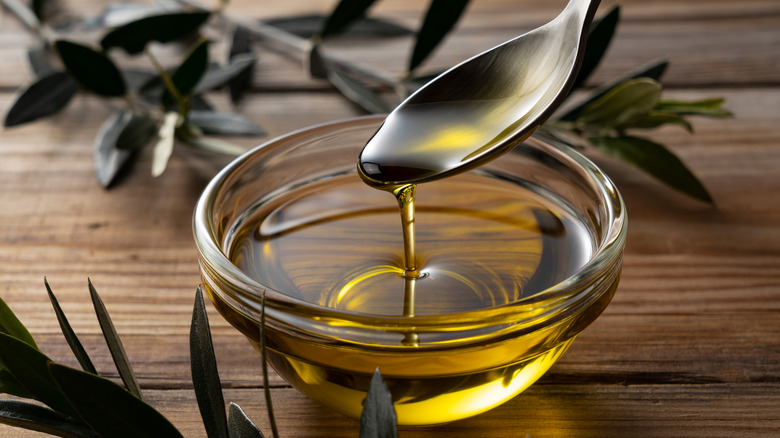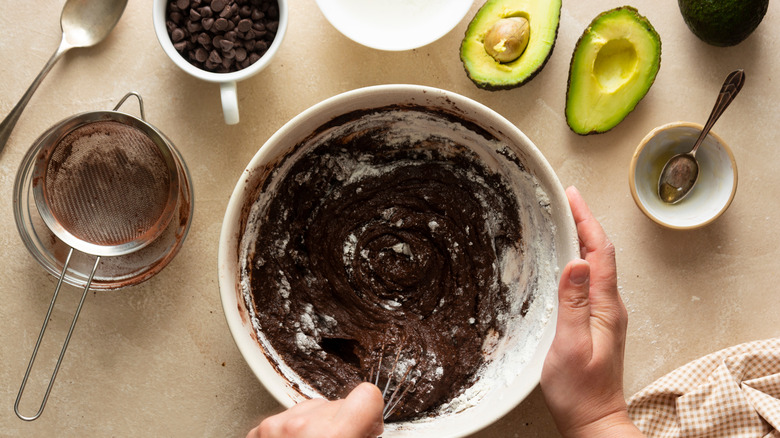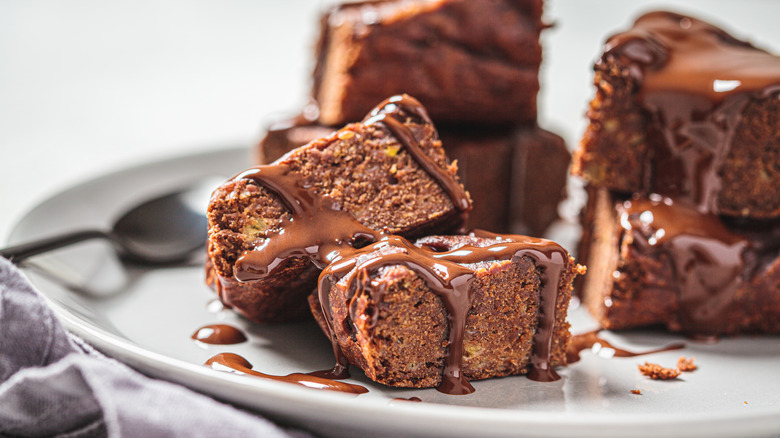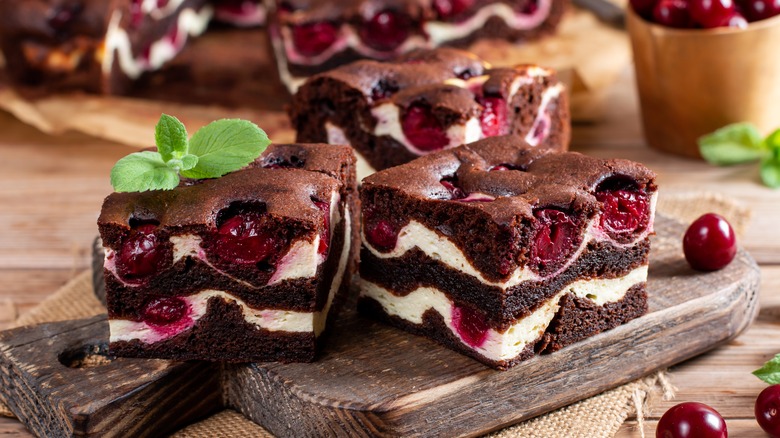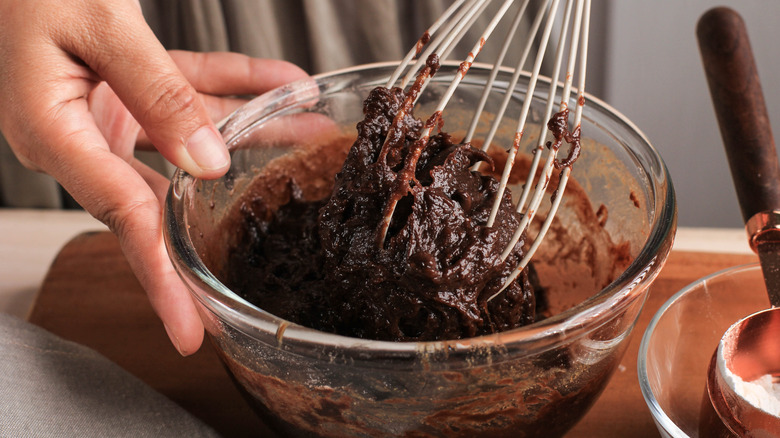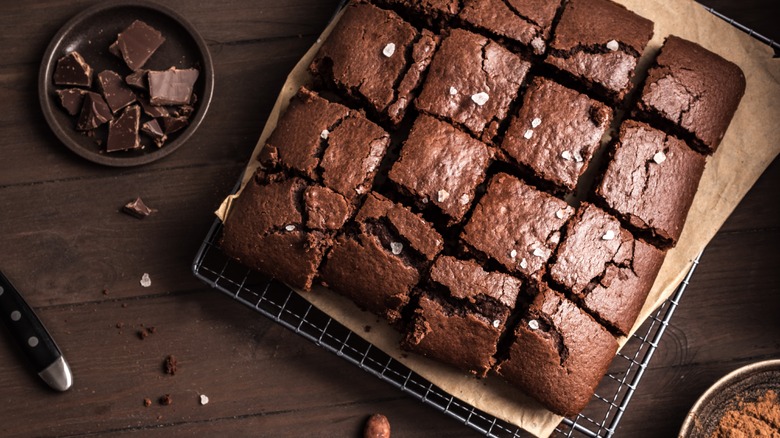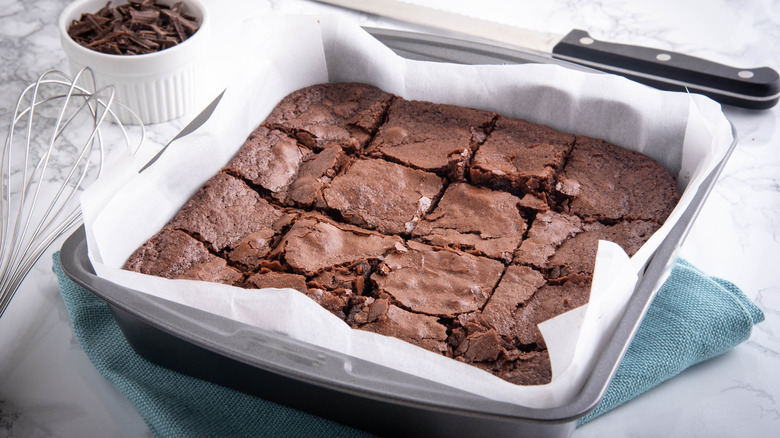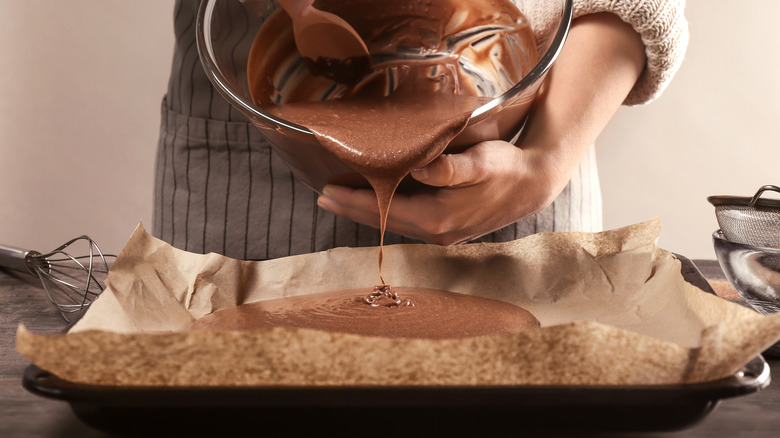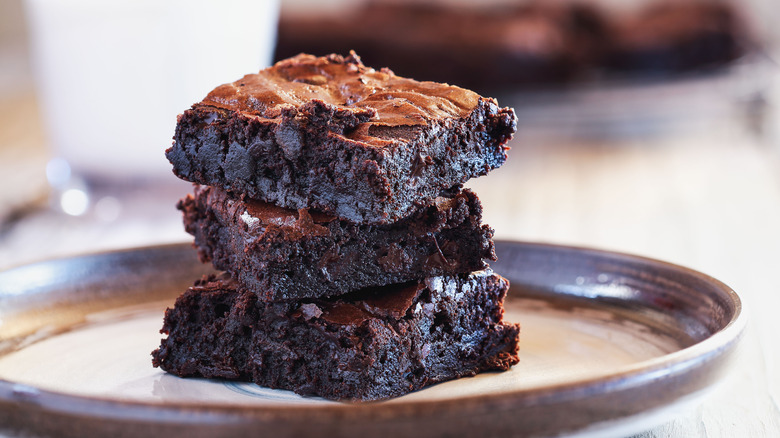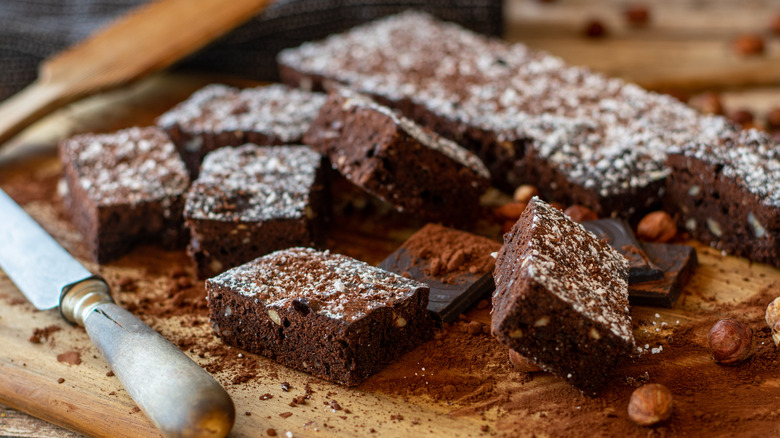14 Brownie Baking Hacks You'll Wish You Knew Sooner
There's just something special about brownies. The smell of freshly baked homemade brownies warm from the oven is enough to tempt anyone; the aroma is rich, buttery, nutty, and utterly irresistible. We all have diverse views about what makes the best brownie (chewy, cakey, fudgy?), but there's no doubt that it's almost impossible not to enjoy a rich, chocolatey, indulgent, and decadent brownie laden with clotted cream or cold vanilla ice cream.
According to Forbes, we have philanthropist Bertha Palmer to thank for creating brownies. In 1893 Chicago hosted the Columbian Exposition, arranged to celebrate the 400th anniversary of Italian explorer Christopher Columbus' voyage to the New World. Palmer was a multi-talented and successful woman who was chair of the "Board of Lady Managers." She instructed the pastry chef of Palmer House to create a dessert that was easy to transport for the World Fair, and it went down a storm. Although it wasn't called a brownie at the time, the original chocolate brownie is still being made at Palmer House.
The first "brownie" appeared slightly later when the Sears Roebuck catalog was published in Chicago in 1898 (via Loop Chicago). The chocolate brownie has evolved somewhat since the 1800s to become one of America's favorite desserts (via Tastewise). There's no need to head out to satisfy your craving, though. Whether you make brownies from scratch or use a box, as long as you are armed with brownie-baking hacks, you'll be an expert in no time.
1. Combine dark chocolate and cocoa powder
Everyone's definition of the best brownie varies; some prefer light, cake-like squares, while others enjoy a moist, fudgy, gooey, and intensely chocolatey affair. We're firmly in the camp of fudgy brownies: They're deeply rich, decadent, and much more satisfying. The key to an irresistibly fudgy brownie rests on a simple factor: Make your brownies with dark chocolate and cocoa powder.
SBS explains that cocoa powder typically causes a lighter crumb and a deeper, intensely chocolatey flavor. Conversely, dark chocolate is sweeter, creamier, and richer; it produces the distinctively dense and ultra-creamy texture we seek. The two are typically used in conjunction to create the ultimate brownie. However, if you prefer a cakey brownie, opt purely for cocoa powder.
Either way, you should use the highest quality ingredients that are available to you, particularly in the case of cocoa powder. Because cocoa powder is made from raw cocoa beans, there's a downside to the concentrated chocolatey flavor: Bitterness.
On the other hand, Dutch-processed cocoa involves treating the cocoa with an alkaline solution that balances the bitterness and produces a fruitier, richer, and mellower effect (per The Washington Post). Bakers generally prefer the latter as it works well with the bitter characteristics of dark chocolate without becoming overpowering.
2. Add a little espresso to boost the flavor
Coffee: Some of us can't imagine starting our day without coffee, and we make a ritual of sipping several cups of coffee a day, while others are less enthusiastic. Whether you're an avid coffee drinker or not, it happens to be the secret ingredient that will take your brownies to the next level. Although caffeinated brownies sound slightly strange, this simple ingredient will take your brownies from standard to sublime.
Using coffee in your baked goods doesn't make them taste like coffee, reassures King Arthur Baking. Instead, the toasty, rich, and fruity notes present in coffee beans elevates and intensifies the natural flavor of chocolate. This makes coffee a splendid way to improve the aroma of poor-quality chocolate or take high-quality chocolate to new heights.
Coffee Friend recommends mixing the dark chocolate used in brownies with espresso, as the robust sharpness of the chocolate perfectly compliments the nutty, caramelized notes in espresso. There's no need to use a lot: Just one and a half teaspoons per 9-by-13-inch batch of brownies is enough to reap the benefits, according to America's Test Kitchen.
3. Cook with room temperature ingredients
Baking can most accurately be described as a science full of precise measurements and chemical reactions. Unlike cooking a pot of pasta or a casserole, when it comes to baking, you cannot add a few extra ingredients here and there, alter the proportions, or easily substitute ingredients. Baking requires you to be meticulous and organized. While brownies are a comparatively forgiving dessert that's excellent for beginners, to achieve the best results, you'll want to plan ahead.
For example, it's vital that you allow your eggs to come to room temperature before you plan to start baking. It may be tempting to toss cold eggs into your batter, but we suggest you think again. According to America's Test Kitchen, the best way to bring eggs to room temperature from the refrigerator is to sit them in warm water for 65 minutes. Otherwise, you're at risk of cold eggs causing drastic temperature changes in the other brownie ingredients and potentially solidifying the melted chocolate and butter.
4. For a shiny cracked crust, beat the eggs and sugar
Aside from the irresistible aroma of chocolate, the first thing you may notice about a tray of brownies is the top; it's unanimously agreed that the best brownies have a glossy, delicate, and shiny top with cracks that reveal the fudgy, creamy texture inside. While bakers dread cracked tops on cakes, pies, and tarts, when it comes to brownies, that crinkled, satiny crust is the sign of a job well done.
If the perfect brownie crust has been elusive, we've got a solution: There's a secret technique for perfectly shiny brownies, and it's easier than you think. The key is to make sure the sugar dissolves and incorporates into your batter, either by beating the egg and sugar thoroughly for a few minutes or whisking the sugar into hot melted butter.
To improve your chances of success, Southern Living has an extra tip to keep in your arsenal. The magazine suggests slamming your tray of brownies on the kitchen counter before popping it in the oven, as it knocks the air out and creates a denser brownie with that evasive cracked crust. Finally, for good measure, be sure to include chocolate chips in the batter, says King Arthur Baking, who suspects it might be the cause of many brownie failures.
5. Use oil instead of butter in your mix
Fats play a critical role in the taste and texture of most foods, and baked goods are no different. There are a range of fats that are used in baking: Butter is most commonly used.
Oils, lard, and even yogurt are becoming more widely utilized in desserts. These fats often aren't interchangeable and can't be directly substituted. Instead, understanding the differences between each option is vital so you can make an informed decision.
According to Rock Bakehouse, butter is a solid fat that is ideal for cakes that require the creaming method: This method beats air into the batter, resulting in a light, airy and fluffy crumb. In contrast, oil is a liquid fat that doesn't hold air, meaning it's a perfect choice for denser bakes with less rise (like brownies). HuffPost notes that oil produces a moist texture and rich flavor, denoting that there's less risk of brownies that will dry out.
There's more room for experimentation, too, depending on the variety of oil you use: Olive oil is particularly pungent yet pairs well with chocolate, coconut oil adds nuttiness, and walnut oil brings a sweet, buttery flair. You could even use chili or lemon-infused oils if you're feeling brave.
Finally, The Washington Post points out that baking with oil requires less work and fewer dishes than butter, which is a win-win in our books. Who doesn't want less mess to tidy up?
6. Or, swap out both for avocado
Cooking brownies probably isn't the first thing that comes to mind when you pick up an avocado at the grocery store. More likely, you're shopping for guacamole to serve with corn chips or planning avocado toast for the morning. What if we told you that using avocado in your brownie mix creates a moist, velvety, fudgy texture to your dessert, with added health benefits too?
According to Medical News Today, avocadoes are an excellent source of essential vitamins and nutrients that, among other things, help to support heart and bone health. Avocados also contain high levels of folate, which a study published in the Journal of Psychiatric Research has linked to lower levels of depression. We're already feeling better at the prospect of indulging in decadent brownies with so many wholesome bonuses.
Cookbook author Robin Miller urges that puréeing or mashing a ripe, softened avocado to a creamy, silky texture will provide you with the best results. We recommend looking at the bottom of the pile to pick perfectly ripe avocados for making brownies.
7. Make your brownies vegan with aquafaba
Aquafaba was once a secret that was only known to adventurous vegan bakers. Today, it is becoming more and more mainstream.
You won't need to look far for this specialty ingredient, as it's more accessible than you may think: In fact, you've probably got some sitting in your kitchen cabinets right now. Aquafaba is the brine used in canned chickpeas, and it's a versatile cooking ingredient that is used to make vegan mayonnaise, meringue, mousse, hummus, and brownies.
To extract the aquafaba, drain the brine into a bowl and reserve the chickpeas for another use. When beaten with a hand whisk, the liquid magically transforms into a light, airy foam and then whips into a thick, glossy mixture. Aquafaba has similar properties to egg white, and it can provide structure and fluffiness to bakes, according to America's Test Kitchen.
Even if you don't subscribe to a plant-based diet, there's no downside to using aquafaba; it's cheap, accessible, and performs flawlessly. You can freeze aquafaba in ice cube containers for convenience since thawed aquafaba performs just as well as fresh aquafaba.
8. Add an extra layer or fancy topping
One of the easiest ways to make your brownies seem instantly more impressive is to add a topping or extra layer. It could be anything from nuts, fruits, spreads, or even cookies: Each layered ingredient will add an extra boost of flavor and texture. Even though we pioneer homemade brownies, adding a creative topping is one of the best hacks to make boxed brownie mix taste homemade (shh, we won't tell anyone).
The possibilities are endless, so feel free to go wild. We suggest starting with a classic cream cheese brownie, then experimenting with toppings. Think drizzled chocolate, toffee sauce, caramel, Biscoff, Oreos, peanut butter, and marshmallows: The sky is the limit! On the flip side, fruits (especially berries) are best directly mixed into the batter to supply a pop of intensely tart juiciness. The same can be said for nuts; we recommend chopped walnuts, as they have a mild, sweet flavor and satisfying crunch.
9. Don't overmix your batter
Did you know that how you mix your brownies determines how fudgy they are? In an interview with Fodor's, cookbook author Jessie Sheehan revealed that one of the biggest mistakes you can make when baking is overmixing your batter. She emphasizes that once you add flour to the batter, you should mix it by hand with a spatula, employing a gentle touch. This tip rings particularly true of brownie batter, as beating ingredients incorporates air into the batter and results in a light bake with a high rise, which is a less-than-ideal result if you're hoping for fudgy and moist brownie squares (via Institute of Food Science & Technology).
Contrastingly, Oregon Live suggests that since fudgy brownies have a high proportion of fat (chocolate, oil, or butter) as compared to dry ingredients (flour), it's hard to overmix, and there's little risk of the brownies turning tough or dry. The source further recommends that if your brownie recipe contains more than four ounces of chocolate and less than half a cup of flour, you can afford to mix it more. We recommend that you aim for a thick and glossy batter and err on the side of caution.
10. Sprinkle flaky sea salt on top
If you're anything like us, baking probably makes you think of sweet treats and all things sugary. However, we can't understate the importance of salt in your baked goods; without it, your chocolate brownies wouldn't taste as good, explains Science.org. According to studies conducted by researchers at a Tokyo-based Dental College, the presence of salt in addition to sugar seems to amplify and heighten the sensation of sweetness: In other words, salt appears to make sugar sweeter.
The Science of Cooking confirms that the primary purpose of salt is to enhance the flavor of other, more prominent ingredients. It should increase the complexity and depth of your baked goods without becoming overwhelming. Imagine your favorite chocolate bars with a gooey salted caramel center, and everything will begin to make sense. Your batter should include a pinch of fine table or sea salt. We love elevating the flavor of chocolate even more by sprinkling flaked salt on top of just-out-of-the-oven brownies. You can even try homemade orange-flavored salt to add a hint of sweet tartness.
11. Use an aluminum pan for baking
Ceramic, glass, aluminum, stainless steel, stoneware, cast iron, and enamelware: When it comes to cookware, there are so many different materials to pick from, and each has a unique purpose in your kitchen. Don't be fooled into thinking that it doesn't matter which material you opt for when making brownies, as the wrong type of pan can easily lead to overcooked brownies, hard edges, or any number of other disasters.
According to Clean Eating Mag, glass and ceramic pans are bad heat conductors, meaning they take more time to heat up. However, once the pan is hot, the temperature will remain stable and constant. This results in two things: Firstly, your brownies will bake evenly from the edges to the center, and secondly, they'll continue to cook after you remove them from the oven.
Instead, bake brownies in an aluminum pan (or another light metal), as it conducts heat well, handles high temperatures, cools down quickly, and is affordable. Save your glass and ceramic for casseroles or fruit crumbles: Aluminum reigns supreme for brownies.
12. Line your pan with parchment paper
Have you ever accidentally forgotten to line your baking trays with parchment paper? Have you forgone greasing the pan in frenzied eagerness to get your brownies into the oven as soon as possible? It has happened to the best of us, and it's always a messy disappointment.
Although it may be simple, lining your trays with parchment paper is one of the best hacks for great brownies. As Minus G points out, parchment paper helps to regulate the temperature of your baking tins, ensuring that your brownies bake evenly. Of course, parchment paper also prevents sticking and makes it easy to lift your brownies from the cookware, permitting you to cut perfect brownies effortlessly.
We've even got you covered if you're struggling to line your baking tins. It turns out that this unexpected office supply will make baking perfect brownies easier: Can you guess it? Use metal binder clips (don't use plastic, as they'll melt) to hold your parchment paper in place when you pour in the brownie batter. It prevents the parchment paper from moving around and allows you to spread that batter perfectly to the edges. Remove the binder clips when you're ready to lift the brownies out.
13. Take your brownies out while they're still moist
Whether you're craving a fudgy, gooey-in-the-center brownie or a cakey, chewy brownie, the worst thing you can do is let your batch spend too long in the oven. Although it's easy to get distracted and forget about the brownies, even one minute can make or break the texture of your bake. We suggest setting a kitchen timer to remind you a few minutes before the brownies are due to come out of the oven. Otherwise, you'll potentially end up with dry, crusty, and even burnt brownies that are not fit for eating. To avoid this, you should consider under-baking your brownies, as due to the residual heat from the pan, they'll continue to cook after you take them out of the oven.
Since all ovens vary slightly, don't solely rely on recipe timings. Instead, we advise using the toothpick test on homemade brownies. A few minutes before your brownies finish cooking, stick a toothpick into the center of your brownie. If your brownie is ready, the toothpick should have a slight chocolate goo and a few crumbs but no runny texture (via Baking How). If they're still too undercooked, pop them back in the oven and check on them again in a few minutes.
14. Cool the brownies before you cut them
You've put in all that hard work: You've bought the ingredients, mixed the batter, lovingly poured it into the tin, and even taken it out of the oven at just the right time to ensure the perfect texture. But then you make a fatal mistake. The mouth-wateringly rich and nutty mocha aroma is wafting through the air, and you can't resist: You cut into the hot brownie, and it falls apart.
One thing is key to avoiding this frustration: Patience. If you cut into your brownies too soon, the batter won't have time to set. Preferably, you should leave the brownies on the counter until they reach room temperature or leave them to set in the fridge.
Once the brownies have come to room temperature, you'll be able to cut them into lovely neat squares effortlessly. Remove the brownies from the tray by lifting out the parchment paper, then use a large knife to make controlled cuts. You may find that your knife gets sticky between cuts, especially if you've baked fudgy brownies, but there's an easy way to prevent the batter from sticking to your knife: Grease it with oil in-between cuts for clean, even slices.
And the best part? You can still enjoy warm, sticky brownies. It's straightforward to reheat them in the microwave or even a conventional or toaster oven, according to Baking How.
